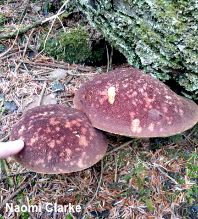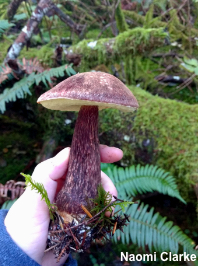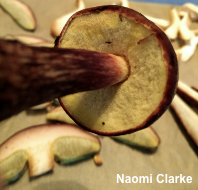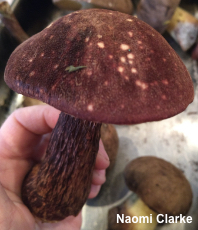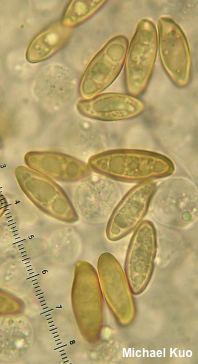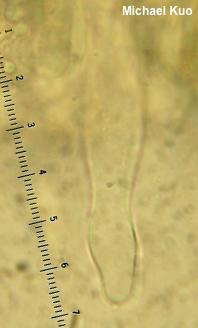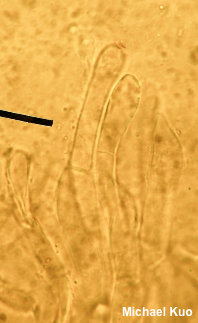| Major Groups > Boletes > Aureoboletus mirabilis |

|
Aureoboletus mirabilis [ Basidiomycota > Boletales > Boletaceae > Aureoboletus . . . ] by Michael Kuo Aureoboletus mirabilis is a denizen of hemlock forests in the Pacific Northwest, from northern California to Alaska. Unlike most boletes it is usually found growing on or near well-decayed, moss-covered stumps. Its dark brown to dark reddish brown cap has a granular-felty texture; its yellow pore surface does not change color when bruised; and its gorgeous stem is dark brown streaked with paler areas, and usually coarsely reticulate near the apex. Under the microscope Aureoboletus mirabilis features large spores, long cystidia, and a trichoderm. Boletus mirabilis, Boletellus mirabilis, and Xerocomus mirabilis are synonyms. Thanks to Naomi Clarke for documenting, collecting, and preserving Aureoboletus mirabilis for study; her collection is deposited in The Herbarium of Michael Kuo. Description: Ecology: Mycorrhizal; associated with hemlocks; growing alone, scattered, or gregariously on well-decayed, mossy hemlock stumps and logs—or terrestrially in the vicinity of hemlock stumps; fall and winter; distributed from northern California to Alaska. The illustrated and described collection is from Oregon. Cap: 8–16 cm; convex, becoming broadly convex or slightly bell-shaped; dry; granular-felty, becoming finely scaly with age; brownish red to brownish purple; the margin with an overhanging, sterile portion. Pore Surface: Bright to dull yellow when young; becoming olive yellow as spores mature; not bruising; about 1 pore per mm at maturity; tubes to 2 cm deep. Stem: 7–10 cm long; 1.5–3 cm thick; club-shaped, especially when young; solid; yellow at apex but elsewhere dark brown to dark reddish brown, streaked with paler areas; not bruising; bald below and sometimes overall, but usually coarsely reticulate over the upper portion. Flesh: Whitish to pale yellowish; sometimes purplish under the cap cuticle; not staining on exposure. Odor and Taste: Not distinctive. Spore Print: Olive brown. Microscopic Features: Spores 16–22 x 6–8 µm; fusiform; smooth; golden in KOH. Basidia 4-sterigmate; about 40 x 12.5 µm; clavate. Hymenial cystidia 60–80 x 7.5–12.5 µm; cylindric to fusiform; smooth; thin-walled; hyaline in KOH. Pileipellis a trichoderm; elements 4–8 µm wide, smooth or slightly encrusted, hyaline to golden in KOH; terminal cells subclavate, or cylindric with rounded apices. REFERENCES: (Murrill, 1912) Halling, 2015. (Thiers, 1966; Snell & Dick, 1970; Smith & Thiers, 1971; Thiers, 1975; Smith, Smith & Weber, 1981; Arora, 1986; Phillips, 1991/2005; Both, 1993; Lincoff, 1992; Bessette, Roody & Bessette, 2000; Miller & Miller, 2006; Trudell & Ammirati, 2009; Wu et al., 2014; Desjardin, Wood & Stevens, 2015; Halling et al., 2015; Siegel & Schwarz, 2016.) Herb. Kuo 08091505. This site contains no information about the edibility or toxicity of mushrooms. |
© MushroomExpert.Com |
|
Cite this page as: Kuo, M. (2019, November). Aureoboletus mirabilis. Retrieved from the MushroomExpert.Com Web site: http://www.mushroomexpert.com/aureoboletus_mirabilis.html |
